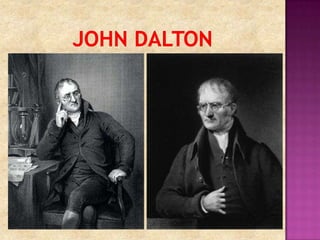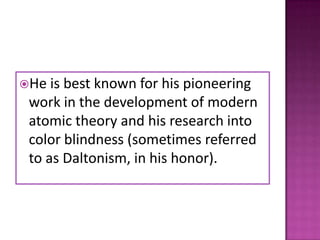John Dalton (Biography)
- 3. ÔÉò Born: September 6, 1766 ÔÉò Birthplace: Cumberland, England ÔÉò Gender: Male ÔÉò Father: Joseph Dalton ÔÉò Mother: Deborah Greenup ÔÉò Siblings: Jonathan & Mary ÔÉò Occupation: Teacher, Chemist, Meteorologist & Physicist ÔÉò Died: July 27, 1844 ÔÉò Cause of Death: Paralysis & Stroke
- 4. ÔÇû John received his early education from his father and from John Fletcher, teacher of the Quaker school at Eagles field. ÔÇû This youthful venture was not successful, the amount he received in fees being only about five shillings a week, and after two years he took to farm work.
- 5. ÔÇû He had received some instruction in mathematics from a distant relative, Elihu Robinson, and in 1781 he left his native village to become assistant to his cousin George Bewley, who kept a school at Kendal.
- 6. ÔÇû John Dalton lived and worked in England as a teacher and public lecturer. ÔÇû He began teaching when he was 12. He taught for 10 years at a Quaker boarding school in Kendal, and then he moved on to a teaching position at the city of Manchester.
- 7. ÔÇû John Dalton was seriously interested in meteorology for the longest time. ÔÇû He seems to have thought of taking up law or medicine, but his projects met with no encouragement from his relatives and he remained at Kendal till, in the spring of 1793, he moved to Manchester.
- 8. ÔÇûJohn Gough, a blind philosopher to whose aid he owed much of his scientific knowledge, he was appointed teacher of mathematics and natural philosophy at the New College in Moseley Street (in 1880 transferred to Manchester College, Oxford), and that position he retained until the removal of the college to York in 1799.
- 9. ÔÇû Hewas appointed teacher of mathematics and natural philosophy at the New College in Moseley Street (in 1800 transferred to Manchester College, Oxford), and that position he retained until the removal of the college to York in 1799, when he became a public and private teacher of mathematics and chemistry.
- 10. ÔÇûHe is best known for his pioneering work in the development of modern atomic theory and his research into color blindness (sometimes referred to as Daltonism, in his honor).
- 11. Elihu Robinson a competent meteorologist and instrument maker, who got him interested in problems of mathematics and meteorology. John Gough a blind philosopher to whose aid he owed much of his scientific knowledge.
- 12.  Meteorological Observations and Essays (1793)  Elements of English Grammar  “Daltonism” (Color Blindness)
- 14. When John Dalton died, 40,000 people attended his funeral procession.
- 16. ÔÇû http://www.biographybase.com/biograp hy/Dalton_John.html ÔÇû http://chemicalheritage.net/discover/on line-resources/chemistry-in- history/themes/the-path-to-the- periodic-table/dalton.aspx
- 17. Thank You for Listening! God Bless ÔÅä


















